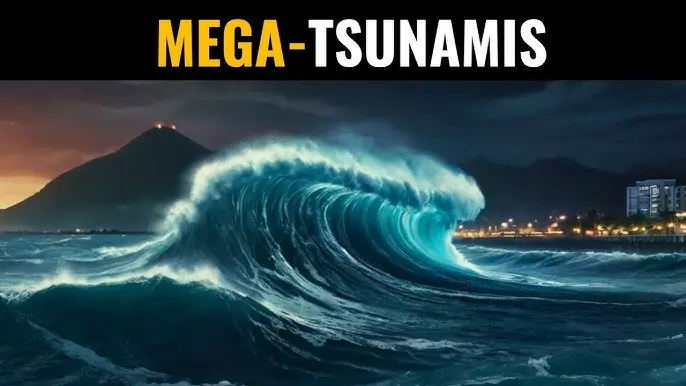Imagine waking up one morning, and the Earth is literally thudding every 90 seconds. No, it’s not your neighbor’s washing machine—
it’s Greenland casually dropping a chunk of itself into the ocean, causing a 650-foot mega-tsunami. Welcome to one of the most bizarre real-life disaster stories of our time.

In September 2023, something massive happened in one of Earth’s most peaceful-looking places. A gigantic landslide in Dickson Fjord, Greenland,
triggered a tsunami that shocked scientists, triggered global seismic waves, and sent curious minds into a frenzy.
Let’s dive into what happened, why it matters, and how it quite literally shook the Earth.
What Is Dickson Fjord and Why Should We Care?
Dickson Fjord is a remote, icy fjord in Greenland, known more for its postcard views than earth-shattering headlines.
But beneath that icy beauty lies a geological bomb ticking slowly—thanks to melting glaciers, unstable mountain slopes, and (you guessed it) climate change.
On September 15, 2023, a section of the mountain beside the fjord collapsed into the water, unleashing an unimaginable wall of water over 650 feet (200 meters) high. That’s taller than the Statue of Liberty. Twice.
The Big Boom: What Happened?
- A large landslide, invisible to humans due to the area’s remoteness, slid down into the fjord
- The impact displaced a massive volume of water, creating a tsunami wave of 650 feet
- The shockwave was so strong, it sent vibrations through the Earth—every 90 seconds
- These vibrations were recorded for 9 consecutive days across seismic stations globally
Yes, the Earth literally thumped in rhythm—like it was attending its own heavy metal concert.
How Did We Even Discover This?
The superhero of this story? NASA and CNES’s SWOT satellite (Surface Water and Ocean Topography), which just happened to be orbiting overhead. It spotted:
- Water level shifts post-event
- Wave propagation in the fjord
- Topographical changes after the landslide
SWOT helped scientists confirm that this was not just some local ripple—it was a global event.
Why Was This Tsunami So Unique?
You’ve heard of earthquakes causing tsunamis. But this was different.
It wasn’t caused by an earthquake but by a climate-induced landslide. That’s what made it so significant. Let’s break it down:
| Feature | Greenland Tsunami | Typical Tsunami |
|---|---|---|
| Cause | Landslide due to glacier melt | Earthquake or underwater explosion |
| Height | ~650 feet | ~30–100 feet |
| Duration of global impact | 9 days (seismic echoes) | Few hours |
| Detected by | SWOT satellite, global sensors | Ocean buoys, seismometers |
Seiche Phenomenon: Earth’s Weird Wave Machine
Here’s where it gets spooky-sciencey.
After the tsunami, the fjord experienced a “seiche” — a standing wave in an enclosed body of water. Think of it like the water in your bathtub sloshing back and forth—but the tub is miles wide and the water is freezing.
This seiche bounced inside the fjord every 90 seconds, making the ground vibrate globally, like a giant’s footsteps echoing through the crust of the Earth.
Climate Change: The Real Villain Here?
This mega-tsunami wasn’t just a freak natural event. Scientists believe that climate change played a major role, by:
- Melting glaciers that once supported the cliffs
- Softening permafrost, weakening the mountainside
- Increasing water saturation, making landslides more likely
“Climate change isn’t just about warmer summers—it’s about tsunamis that nobody sees coming.”
— Random annoyed scientist, probably.
FAQs People Are Searching (and You Now Know the Answers To)
Q: How tall was the Greenland mega-tsunami in Dickson Fjord?
A: Around 650 feet (200 meters) high. That’s like a skyscraper of water.
Q: Was this tsunami caused by an earthquake?
A: Nope! It was a landslide-triggered tsunami, possibly fueled by glacier melt.
Q: Did anyone die?
A: Thankfully, no casualties were reported. The area is extremely remote and uninhabited.
Q: Why did the Earth shake every 90 seconds?
A: A seiche wave inside the fjord caused continuous bouncing, creating rhythmic seismic signals.
Q: How did scientists find out?
A: NASA’s SWOT satellite, combined with global seismic sensors, uncovered the mystery days later.
Could This Happen Again?
Oh yes. In fact, scientists warn that similar landslide-triggered tsunamis could become more common due to:
- Increased glacier retreat
- More unstable slopes in polar regions
- Rising sea levels increasing pressure on shorelines
Greenland, Alaska, and even Norway’s fjords are being monitored closely for similar threats.
Technology Saves the Day (Again)
Without satellite monitoring, we would’ve never known about this. That’s scary and fascinating.
Modern satellites like SWOT are now becoming our climate detectives, uncovering hidden disasters that even local people might miss.
Also, seismic networks worldwide now have more data to analyze unusual wave patterns—potentially giving future warning signs if a landslide is about to trigger another fjord monster.
Greenland Said “Hold My Ice”
Let’s not pretend this wasn’t straight out of a disaster movie.
Greenland looked at 2023’s chaos and said, “Hold my ice, I’ll drop a mountain and go viral.”
While the world was busy with elections, wars, and AI panic, Greenland’s fjords casually made history—and then went quiet again like nothing happened.
Nature’s Power Is Humbling
This event was a wake-up call—not just about geology, but about how interconnected our world is. One landslide in the Arctic can send shockwaves around the globe. Literally.
Whether it’s climate change, satellite tech, or the Earth’s oddly rhythmic heartbeat, the Dickson Fjord tsunami reminded us that:
“We don’t just live on Earth… we live with it.”
